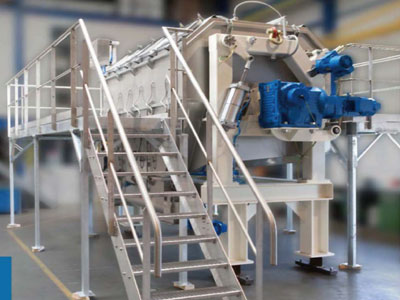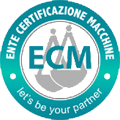HCQP ROTARY DRUM TYPE
Overview
Rotary drum type slicer is mainly used to process chemical and pharmaceutical products. However, the application of these machines in the food industry is gradually being discovered. The enclosed design is ideal for toxic products and dissipative products. The rotary drum slicer converts the product in a molten state into a solid form. The film layer of the product in liquid form adheres to the outside of the cartridge in which the cooling system is placed and continuously rotates. By contacting the surface of the cooled cylinder, the product solidifies and cools the desired final temperature. Finally, the fixed scraper removes the solidified layer from the cartridge and splits it. The rotary drum slicer is mainly used to produce thin sheets, but there are also ways to convert your crystals into easy-to-handle mirrors or granules.

Structure and Work Flow
The equipment consists mainly of a cooling drum mounted on the frame, a discharge scraper, a feed system,a drive assembly and an automated control system. The required sheet size is achieved by system controlled peripheral speed, film layer thickness, and blade angle.The chill rolls are available in a variety of materials depending on the chemical properties and adhesion of the product to be processed. Materials range from fine grain cast iron to carbon steel to Hastelloy. The rollers are specially designed for maximum geometric stability. A spray driven by a central spray pipe is arranged on the inner surface of the drum. The turbulent flow of the spray coolant ensures maximum heat transfer across the surface of the roll. Therefore, an equilibrium temperature over the entire length of the roll is ensured,eventually forming a uniform sheet. The accumulated coolant is sucked from the lowest position in the drum by a siphon. The rigid structure is designed to evenly distribute the pressure across the barrel and eliminate vibration. The blanking blade pressure is acted upon by the pneumatic pressurization system. For the entire closed mechanical device, the blade pressure system is located outside of the processing environment. There are many materials for the doctor blade, from steel to special plastics.
The feeding form of the equipment can be divided into bottom feeding and top feeding:
The bottom feeding form is suitable for materials with low viscosity and good adhesion properties. The rotating drum is directly immersed in the molten material in the heating plate at the bottom of the drum. Immediately upon contact between the drum and the molten material, a film of material is formed and solidified on the surface of the drum. In addition to this, a thin layer of liquid adheres to the solid layer and is transferred out of the heating pan and then solidifies as the roll completes one cycle. This system is used for materials with low viscosity and good adhesion to metal surfaces.The top feeding form is used for precise control of the final thickness and shape of the material. The high temperature distribution roll is located on the upper part of the chill roll. The molten material is fed from a nip between the distribution roll and the chill roll. Contact of the material with the distribution roll ensures that the material remains liquid in the feeding system. The high temperature baffle is placed between the roll gaps of the fabric roll to prevent the molten material from leaking from both sides after thermal expansion. The molten film passes through the gap between the distribution roll and the chill roll and sticks to the chill roll to solidify. This model is suitable for materials with poor adhesion to metals and medium to high viscosity, and the thickness of the sheet can be precisely controlled by the roll gap setting device of the distribution roll.
Main feature
1. Airtight operation, can be used for toxic gas ambiguous products.
2. High heat exchange efficiency and stable products.
3. Fully automatic operation, low labor intensity.
Applicable scope
The equipment is widely used in the production of fine chemicals, food and medicine, which is embodied in the following aspects: 1.Applicable products for bottom feeding type rotary drum slicer: phthalic anhydride, caprolactam,fatty acid, bisphenol, naphthalene, dimethyltryptamine, etc. 2.Applicable products for top feeding type rotary drum slicer: soap, stearate, fatty acids, etc.
Specifications and technical parameters
Model ITEM | HCQP-1.5 | HCQP-2.5 | HCQP-4.0 | HCQP-5.5 | HCQP-7.0 | HCQP-8.5 | HCQP-11 | |
| Heat exchange area(m2) | 1.5 | 2.5 | 4 | 5.5 | 7 | 8.5 | 11 | |
| Drum specification(mm) | Diameter | Φ600 | Φ800 | Φ1000 | Φ1200 | Φ1500 | Φ1500 | Φ1800 |
| Length | 800 | 1000 | 1300 | 1500 | 1500 | 1800 | 2000 | |
| Drum rolling speed (rpm) | It's able to selection between 0.3~25rpm according to different nature of materials. | |||||||
| Dimension(mm) | L | 2100 | 2400 | 2800 | 3100 | 3200 | 3600 | 4000 |
| W | 950 | 1250 | 1550 | 1850 | 2000 | 2400 | 2700 | |
| H | 1700 | 1900 | 2200 | 2400 | 2800 | 2800 | 3300 | |
| Motor power(Kw) | It's able to selection between 2.2~30Kw according to different nature of materials and distribution method. | |||||||
| Material | Carbon steel, stainlesss steel, hastelloy, etc. | |||||||
| Weight(T) | 1.3 | 1.8 | 2.9 | 3.8 | 4.7 | 6.5 | 8.8 | |


